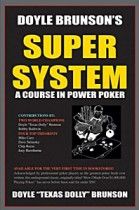
Book Review - Doyle Brunson’s Super System: A Course in Power Poker
Author: Doyle Brunson
Year: 2002
Print house: Cardoza Publishing
Doyle Brunson's Super System (sometimes written as Super/System) hit shelves in 1979 just a few years after his back-to-back WSOP Main Event wins in 1976 and 1977. The original title for the book was How I Made $1,000,000 Playing Poker and sported a considerable price tag of $100 per copy.
Despite this, it became an instant classic and a seminal work of poker strategy.
A popular edition was published in 2002 by Cardoza Publishing with a more reasonable price tag.
An updated edition, titled Super/System 2 came out three years later under the same colophon.
| Publisher | B & G Publishing Co (later editions: Cardoza Publishing) |
| Year of Publish | 1979 |
| Number of Pages | 606 |
| Languages | English |
| Editor’s Rating |
Doyle Brunson’s Super System Poker Book - A Quick Overview
Doyle Brunson's Super System begins with a brief autobiographical sketch by the main author before launching into a general guide on poker. With the fundamental ideas—like pot odds and outs—covered, the book then switches to a series of chapters on various poker variants.
Several of the strategy chapters are contributed by the book's five contributing authors.
Mike Caro wrote a chapter about five card draw (covering tells in some detail) and contributed a table of poker stats. Chip Reese contributed a chapter about seven card stud. David Sklansky covered stud hi/lo. While Bobby Baldwin covered limit hold'em.
Doyle co-wrote the lowball chapter with Joey Hawthorne and put together the no-limit holdem chapter himself. It is this final chapter that really earned the book its reputation.
What Elements Of Poker Are In Doyle Brunson’s Super System Book?
Doyle Brunson's poker book was designed to be the Everyman's second poker book. It assumes a familiarity with the rules of poker and its variants and with basic strategic concepts like bluffing, slowplaying, and drawing to a better hand.
However, Doyle Brunson's Super System assumes that the player lacks any more advanced strategic tools, an ignorance it then sets out to dispel.
The section on general poker strategy establishes the principles of tight-aggressive play, pot odds, and reading opponents. The later chapters then demonstrate what is required to implement these principles in the game variants that were popular in the late 70s.
Is Doyle Brunson’s Super System Book Still Relevant Today?
As a historical document, Doyle Brunson’s Super System only becomes more relevant with age. Especially as several chapters are on games that are not played widely in modern times (like five-card draw and seven-card hi/lo without the eights-or-better qualification).
However, much of its strategic advice has been replaced by the huge advances in poker theory over the last half-century.
The broad principles laid out in the book still hold up, but more specific guidance has aged poorly. This is especially true in the hold'em chapters, where advances have been quickest.
Either way, Doyle Brunson’s poker book remains a key influence on all that has come after it.
Will Doyle Brunson’s Super System Book Make you a Better Poker Player?
This really depends on where you are in your poker journey. If you are just starting out, parts of this poker book are an excellent introduction to basic strategic thinking.
The non-holdem sections are well worth reading for a basic intro to each of the games. However, the updated Super System 2 is probably more relevant for modern readers.
Is Doyle Brunson’s Super System Poker Book Worth Buying?
Again, it depends on what you are looking for. As a basic strategy guide, it may well retain its value. Though more advanced poker players might be better served by other resources both online and printed.
However, for anyone curious about Doyle's life story—and about the poker scene in the 1970s—the biographical materials are absolutely worth the price of admission.